Success Story
The multiple faces of community engagement across the Amazon region to tackle COVID-19
March 29, 2024
Through the USAID-funded New Partnerships Initiative (NPI) EXPAND Brazil project, implementation partners worked to increase vaccination against COVID-19 in the Amazon region. In Brazil, NPI EXPAND supports projects dedicated to facing the COVID-19 pandemic and promoting the immunization of vulnerable and isolated communities. These projects show how collaboration among the public, private, and social sectors can encourage capacity strengthening, promote innovation, and improve essential public services, such as the Unified Health System (Sistema Único de Saúde (SUS)) in Brazil.
Bringing together science and community engagement
Efforts to tackle and prevent COVID-19 go hand in hand with combating the spread of false information about the disease. In the Brazilian Amazon region, this battle relies on an important alliance: science and local knowledge. The projects supported by NPI EXPAND Brazil and USAID used different strategies to engage communities and promote vaccination across the region.
The concept of risk communication and community engagement (RCCE) consists of strategies to inform and engage people in actions to reduce the risks to which they are exposed and better protect themselves. Using interculturality as an implementation tool, associated with a deep understanding of the different local contexts, NPI EXPAND’s partners in Brazil were able to promote vaccination against COVID-19 as well as other diseases. Here are just some examples:
Street theater
What: playful and engaging presentations to inform about COVID-19 and encourage people to get vaccinated.
Who: Fundação Vitória Amazônica (FVA), Companhia Brasileira de Artes, Sociedade e Meio Ambiente (CBASMA)
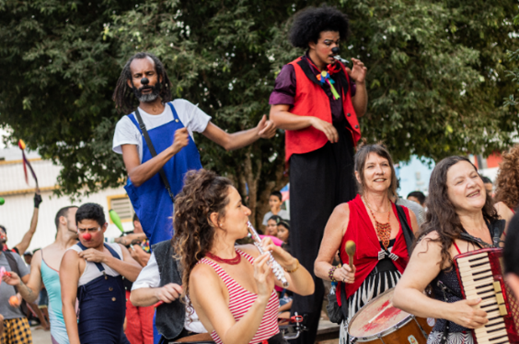 Theatrical procession of the Art&Com Saúde project, implemented by Fundação Vitória Amazônica. The presentations helped bring the population closer to the initiative, which managed to vaccinate more than 2,000 people and raised the vaccination coverage rate in the city of Novo Airão (Amazonas, Brazil) from 23% to 50%. (Photo: Rodrigo Duarte)
Theatrical procession of the Art&Com Saúde project, implemented by Fundação Vitória Amazônica. The presentations helped bring the population closer to the initiative, which managed to vaccinate more than 2,000 people and raised the vaccination coverage rate in the city of Novo Airão (Amazonas, Brazil) from 23% to 50%. (Photo: Rodrigo Duarte)
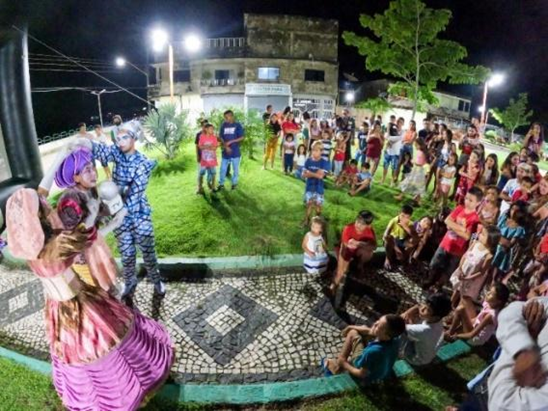 Street theater in the city of Melgaço (Pará, Brazil): CBASMA’s project used theater as an information and mobilization tool. The group traveled through the Amazon River visiting several cities and remote communities to promote vaccination against COVID-19. With the vaccination campaigns combined associated to the play, the project managed to vaccinate more than 2,000 people. (Photo: CBASMA)
Street theater in the city of Melgaço (Pará, Brazil): CBASMA’s project used theater as an information and mobilization tool. The group traveled through the Amazon River visiting several cities and remote communities to promote vaccination against COVID-19. With the vaccination campaigns combined associated to the play, the project managed to vaccinate more than 2,000 people. (Photo: CBASMA)
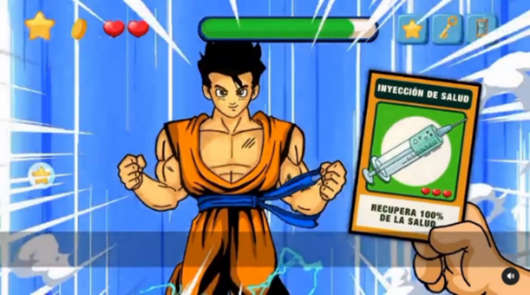 Serviço Jesuíta de Migrantes e Refugiados (Jesuit Service for Migrants and Refugees) implemented the project “Response to COVID-19 in the Brazilian Amazon Region”. Through the initiative, the organization developed a series of informational materials about topics that were constant targets of fake news during the pandemic, such as the effects of vaccines and the importance of getting children vaccinated. See here an example of a post and watch one of the videos here. (Image: SJMR)
Serviço Jesuíta de Migrantes e Refugiados (Jesuit Service for Migrants and Refugees) implemented the project “Response to COVID-19 in the Brazilian Amazon Region”. Through the initiative, the organization developed a series of informational materials about topics that were constant targets of fake news during the pandemic, such as the effects of vaccines and the importance of getting children vaccinated. See here an example of a post and watch one of the videos here. (Image: SJMR)
FAS ran the campaign “Spread Health, not COVID”. The project used pieces of social media to help disprove myths and fake news about COVID-19 and the vaccine. See here an example of a post and watch the campaign videos here. (Image: FAS)
Communications training
What: training in communications practices and tools to disseminate correct information about vaccination and prevention against COVID-19.
Who: Instituto Internacional de Educação do Brasil (IEB) – focused on indigenous communicators, Fundação Vitória Amazônica (FVA) – focused on young communicators.
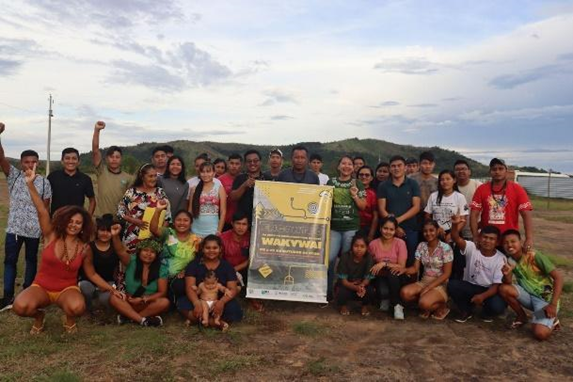 With the project “Indigenous communication networks: weaving ties against COVID-19”, IEB promoted communications training for indigenous peoples. Around 30 communities of the Macuxi, Wapichana, Taurepang, and Yekuana peoples in Roraima, and the Warao people in Pará received the training, which included discussions on traditional indigenous medicine, indigenous communications networks, and strategies to identify and combat misinformation regarding COVID-19. There were also practical workshops for capturing and editing videos, photography, and content production for social media. (Photo: IEB)
With the project “Indigenous communication networks: weaving ties against COVID-19”, IEB promoted communications training for indigenous peoples. Around 30 communities of the Macuxi, Wapichana, Taurepang, and Yekuana peoples in Roraima, and the Warao people in Pará received the training, which included discussions on traditional indigenous medicine, indigenous communications networks, and strategies to identify and combat misinformation regarding COVID-19. There were also practical workshops for capturing and editing videos, photography, and content production for social media. (Photo: IEB)
 As part of the activities of Art&Com Saúde project, FVA offered training for young communicators in the city of Novo Airão. The training combined theoretical knowledge and communications practices with the themes discussed by the project: vaccination against COVID-19 and combating misinformation. (Photo: FVA)
As part of the activities of Art&Com Saúde project, FVA offered training for young communicators in the city of Novo Airão. The training combined theoretical knowledge and communications practices with the themes discussed by the project: vaccination against COVID-19 and combating misinformation. (Photo: FVA)
Jingle and sound-car
What: in many places, the use of sound-cars – cars equipped with loudspeakers that roam the streets of a neighborhood or city advertising or informing about local events – is the most effective means of engaging the local population.
Who: Grupo Mulheres do Brasil (GMB)
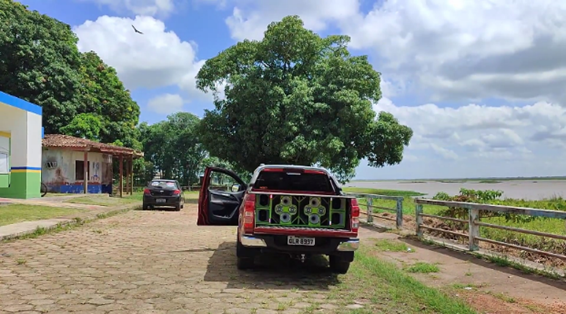 Sound-car used in the Vaccine Now Caravan: the project implemented by GMB helped to increase the immunization coverage against COVID-19 in the state of Amapá by more than 72%, placing Amapá as the second state in Brazil with the best coverage. Listen here to the jingle of the campaign. (Photo: GMB)
Sound-car used in the Vaccine Now Caravan: the project implemented by GMB helped to increase the immunization coverage against COVID-19 in the state of Amapá by more than 72%, placing Amapá as the second state in Brazil with the best coverage. Listen here to the jingle of the campaign. (Photo: GMB)
Different strategies, one goal: tackling and preventing COVID-19
When we talk about “Amazon region” we are not talking about a uniform, homogeneous place. On the contrary, it is a rich and deeply diverse region – in fauna and flora, cultures, communities, peoples, and ways of life. Understanding the needs and habits of each community is crucial to identify communications activities that will be the most successful in that specific place. In addition to the previous examples, projects supported by NPI EXPAND Brazil also used:
- Podcasts: developed together with representatives of the communities. One example is the podcast “Saúde na Floresta” (Health in the Forest), produced by Instituto Juruti Sustentável (IJUS) as part of their activities. The podcast provides tips and information to prevent diseases, in particular COVID-19, and, in addition to being promoted on social media, it was played by a sound-car in some communities. Listen to an episode here.
- Booklets: informative, simple-language materials, easily relatable to the daily life of the community. One example is the booklet produced by ECAM (Amazon Conservation Team), which focused on quilombola populations of Amapá. The material gathers information about COVID-19 specifically for the context of quilombola communities, and strategies to protect the quilombos. Check out the booklet here.
- Local media: use of local communications channels, such as radio, TV, or newspapers, to inform project actions and reinforce messages regarding COVID-19. Saúde e Alegria Project (Health and Joy Project), for example, created the campaign “Shoo, Corona! – Combating COVID-19 in the Amazon”, which consists of articles and interviews on the radio program Alô, Comunidade! (Hello, Community!), broadcasted by the local station of Santarém.
- Online course: virtual learning opportunity to promote the training of health agents and other actors involved in the efforts against COVID-19. Instituto Socioambiental (ISA) promoted the course “Tackling COVID-19 in the Context of Indigenous Health”, aimed at health professionals who work in indigenous communities. The course offered training and up-to-date knowledge on prevention measures in order to ensure better care for indigenous populations.
Strengthening civil society initiatives
The RCCE approach aims to bring critical information to the population on what is known regarding COVID-19, the main health measures people can take to protect themselves, prevention/containment, diagnosis, and treatment. All this is to help the population make the best health decisions, mainly among the most vulnerable groups.
The examples presented here are not exhaustive. Some of the projects have used more than one of the mentioned strategies, and the results make it clear that there is room for multiple possibilities. Each territory and community opens different paths for action. The ultimate goal of risk communication is behavior change. It’s not only possible but also effective and crucial to engage local communities in the fight against COVID-19 and misinformation.